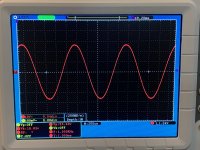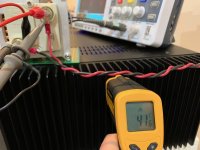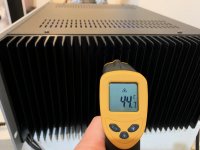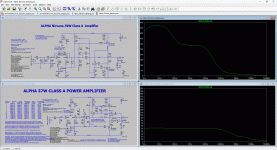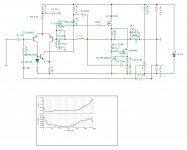The first circuit shown in post #1 has 2N5401 input transistors.
Would it make a difference?
Aah, yes, I see that. However, there is a later circuit ... and BoM. 😀
Irrespective, on X's advice, I will buy some more KSA992 and match them.
I have no idea whether it will make a difference or not - I simply build the circuit the experts have decided upon.
The resistance adjustment does not provide auto temperature tracking provided by a matched pair thermally bonded together.
Aah, OK - thanks, X. 🙂
Can you direct me to a pic which shows how V111 & V112 are (thermally) bonded together?
Andy
100 KSA992 for $7.30
Either 5401 or 992 will work. Just make sure legs are correctly aligned.
btw, I can buy 100 from RS Components here:
https://au.rs-online.com/web/p/digital-transistors/1868558/?relevancy-data=636F3D3126696E3D4931384E53656172636847656E65726963266C753D656E266D6D3D6D61746368616C6C7061727469616C26706D3D5E2E2A2426706F3D31313326736E3D592673723D2673743D43415443485F414C4C5F44454641554C542673633D592677633D4E4F4E45267573743D466169726368696C64204B5341393932465441267374613D466169726368696C64204B534139393246544126&searchHistory=%7B%22enabled%22%3Atrue%7D
... for A$11.20 ... with free delivery!
Andy
Hi Andy,
Look at the transistors on the amp on the left. They are next to the black heat sink. They are flat to flat and covered with (yellow) heat shrink tube. You can squirt some thermal grease in between if you wish. I used yellow heat shrink tube instead of black because I knew someone would ask so it’s easier to point out. 🙂
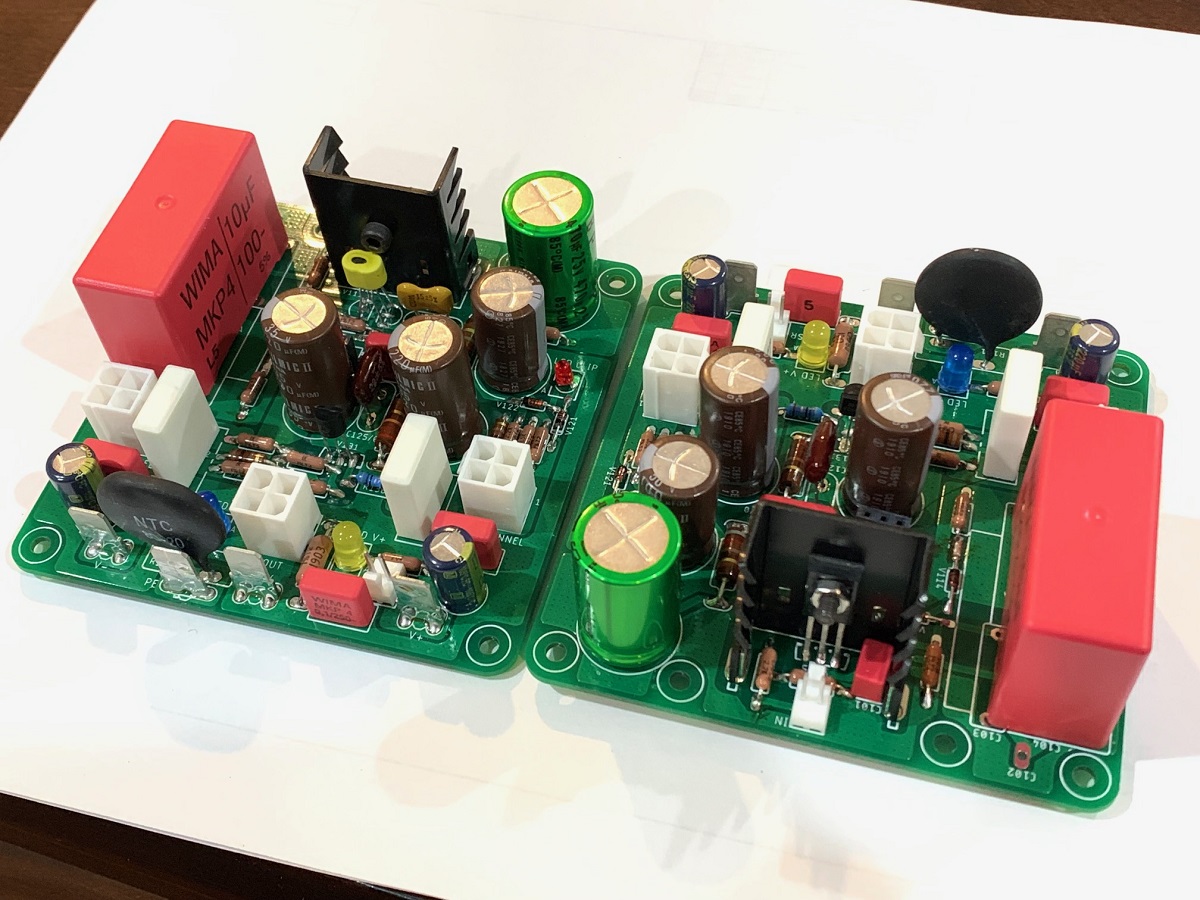
Look at the transistors on the amp on the left. They are next to the black heat sink. They are flat to flat and covered with (yellow) heat shrink tube. You can squirt some thermal grease in between if you wish. I used yellow heat shrink tube instead of black because I knew someone would ask so it’s easier to point out. 🙂
Hi Andy,
Look at the transistors on the amp on the left. They are next to the black heat sink. They are flat to flat and covered with (yellow) heat shrink tube. You can squirt some thermal grease in between if you wish. I used yellow heat shrink tube instead of black because I knew someone would ask so it’s easier to point out. 🙂

Thank you, X - very cool! 🙂
btw, the PCBs that I have (Version 001 12/19/2019) use the pin sequence for KSA992 (ECB!) not 2N5401 (EBC). So I have just ordered 100x KSA992s.
Andy
Last edited:
that is the theory, actual testing will reveal by how much, now is a good time to learn that much..
class A have efficiencies not higher than 50%, theory says...
I ran the test using a 10ohm 300w fan cooled EBG resistor dummy load, I connected an O-scope to show the trace shape to verify that the power delivered was just before clipping (clipping is at about 18.05Vrms on this amp) so I ran it at 17.8Vrms (about 40w at 8ohm but only 32w at 10ohms) with a 1kHz sine wave. Also had a Fluke 115 True RMS meter hooked up to verify the voltage setting. Before starting the test, I let the amp reach steady state temp by listening to soft music for about 45 min. I checked the temp of the middle of the heatsink with an IR thermometer. I got the usual 44.7C. Ambient temp is 20.1C. After 5 minutes, the temp was 41.6C. I ran it another 5 minutes for 10 minutes total and it was 40.1C. The whole time the Oscope trace did not flinch, the amp did not smoke or smell funny, or acted stressed in any way. I think I could run it here indefinitely. In case you have not followed my build, the PSU consists of a 600VA Antek AS-6224 24v transformer. This feeds an SLB PSU with an LT4320 active bridge and CRC followed by a cap multiplier that provides +/-28.5V rails. The amp is running at about 1.7A bias current. That is 200w of total dissipation in the MOSFETs alone and another 10w in the cap multiplier, close to about 1/3rd capacity of the transformer's 600VA rating - not much stress to the system because this is where it runs all the time. Music playing loud or not.
Here is the setup:
Here is a closeup of the Oscope showing the 53.6Vpp signal going into 10ohms:
Here is the IR thermometer after 5 min:
Here is the IR thermometer of the amp at idle and warmed up:
I suppose you were trying to show that if this was a push-pull amp going out of Class A and into Class AB, the temperature would not have decreased at max power?
This is consistent with what 6L6 observed with the Aleph J, another amp using the Pass active CCS.
Attachments
Last edited:
Wonderful measurements, X.
I guess we conclude that we need to run the Nirvana ALPHA hot and heavy to cool the heatsinks.......
Hugh
I guess we conclude that we need to run the Nirvana ALPHA hot and heavy to cool the heatsinks.......
Hugh
So you're suggesting Class A is good for headbanger music, Hugh?? 😀
Andy
😀
53.6Vpp into a speaker 24hrs a day would indeed be head banging music. 🙂
The Alpha Nirvana won’t flinch because it is always operating at full load, and actually runs cooler at max volume. 😀
So if you want your SE Class A amp to last longer, play the music louder.
The Alpha Nirvana won’t flinch because it is always operating at full load, and actually runs cooler at max volume. 😀
So if you want your SE Class A amp to last longer, play the music louder.
Nice measurements X !
Here are simulations for the damping factor,
I've compared the Alpha20 with the Nirvana, both with 8R load.
Top graph is Nirvana.
The damping factor for the Nirvana is 10x higher in simulation.
Probably the Nirvana DF simulation is not correct, Hugh calculated it at as 160.
Still there's no need for higher damping with the Nirvana.
Here are simulations for the damping factor,
I've compared the Alpha20 with the Nirvana, both with 8R load.
Top graph is Nirvana.
The damping factor for the Nirvana is 10x higher in simulation.
Probably the Nirvana DF simulation is not correct, Hugh calculated it at as 160.
Still there's no need for higher damping with the Nirvana.
Attachments
Last edited:
I have not measured the DF in the AN, but subjectively, I do feel that it has fantastic grip of the bass. Thanks for the simulations - I think the higher DF was one of the goals Hugh was trying to achieve. It's a very powerful sounding amp. I am enjoying it immensely.
Danny, X,
I'm not sure how the DF came out so high! I suspect from halving the output device to speaker resistor.
These are amazing figures, Danny. I will email you to discuss it.
Hugh
I'm not sure how the DF came out so high! I suspect from halving the output device to speaker resistor.
These are amazing figures, Danny. I will email you to discuss it.
Hugh
I have not measured the DF in the AN, but subjectively, I do feel that it has fantastic grip of the bass. Thanks for the simulations - I think the higher DF was one of the goals Hugh was trying to achieve. It's a very powerful sounding amp. I am enjoying it immensely.
Use your famous 10 ohm dummy load and easily calculate damping factor by measuring the difference between the unloaded and loaded output voltage 😉
DF = V no load / ( V no load - V loaded ).
You can repeat at different frequencies as DF may vary.
Also DF will vary with the load used. So you should have higher damping factor at 10 ohms than at 4 ohms.
Fab
Fab
Last edited:
I ran the test using a 10ohm 300w fan cooled EBG resistor dummy load, I connected an O-scope to show the trace shape to verify that the power delivered was just before clipping (clipping is at about 18.05Vrms on this amp) so I ran it at 17.8Vrms (about 40w at 8ohm but only 32w at 10ohms) with a 1kHz sine wave. Also had a Fluke 115 True RMS meter hooked up to verify the voltage setting. Before starting the test, I let the amp reach steady state temp by listening to soft music for about 45 min. I checked the temp of the middle of the heatsink with an IR thermometer. I got the usual 44.7C. Ambient temp is 20.1C. After 5 minutes, the temp was 41.6C. I ran it another 5 minutes for 10 minutes total and it was 40.1C. The whole time the Oscope trace did not flinch, the amp did not smoke or smell funny, or acted stressed in any way. I think I could run it here indefinitely. In case you have not followed my build, the PSU consists of a 600VA Antek AS-6224 24v transformer. This feeds an SLB PSU with an LT4320 active bridge and CRC followed by a cap multiplier that provides +/-28.5V rails. The amp is running at about 1.7A bias current. That is 200w of total dissipation in the MOSFETs alone and another 10w in the cap multiplier, close to about 1/3rd capacity of the transformer's 600VA rating - not much stress to the system because this is where it runs all the time. Music playing loud or not.
Here is the setup:
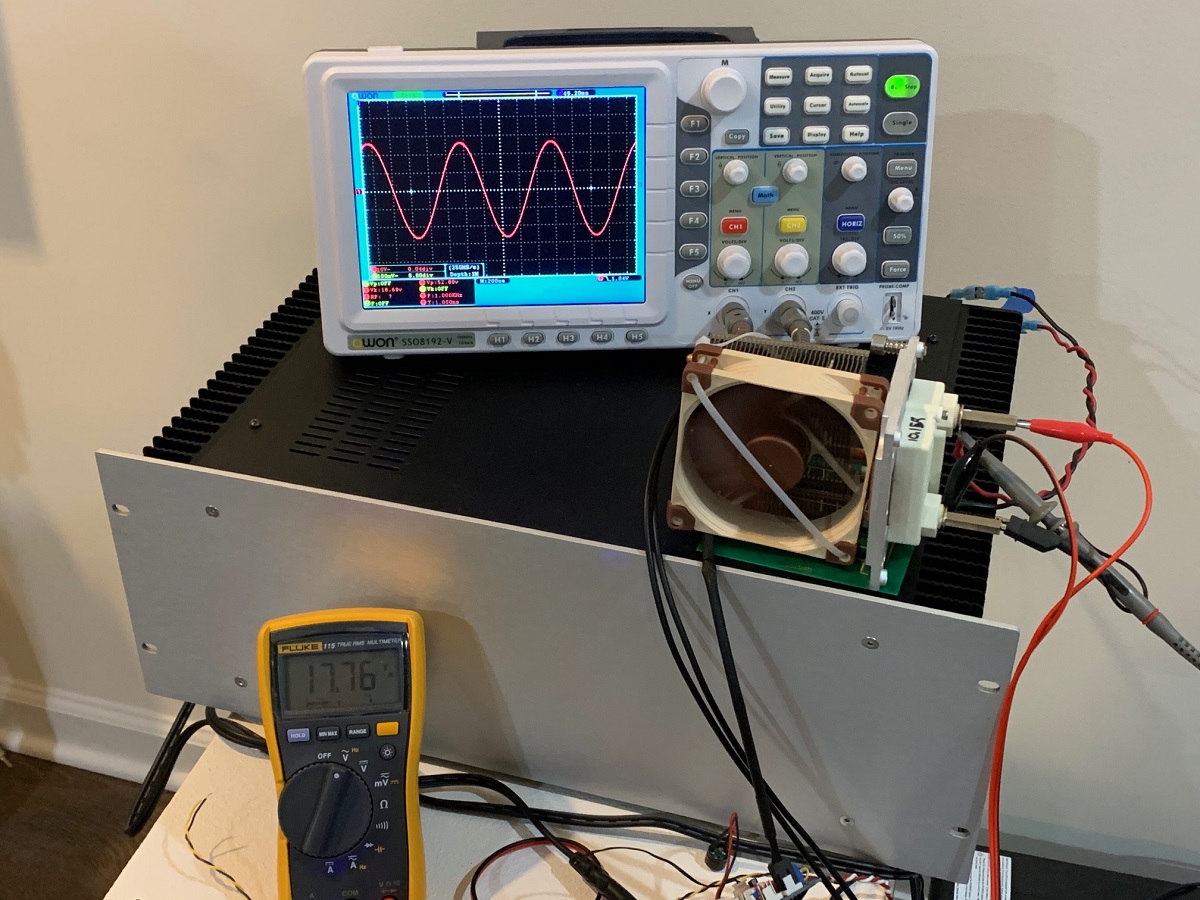
Here is a closeup of the Oscope showing the 53.6Vpp signal going into 10ohms:
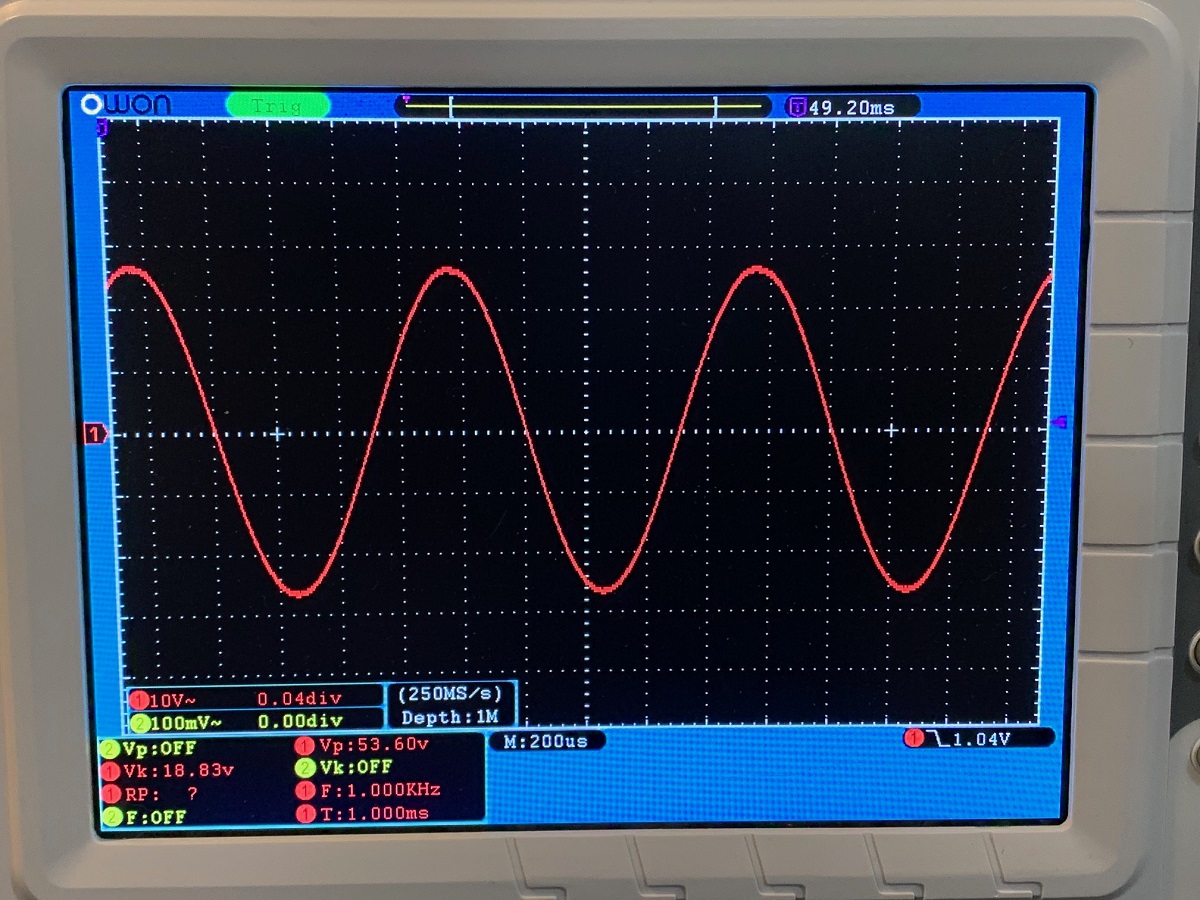
Here is the IR thermometer after 5 min:
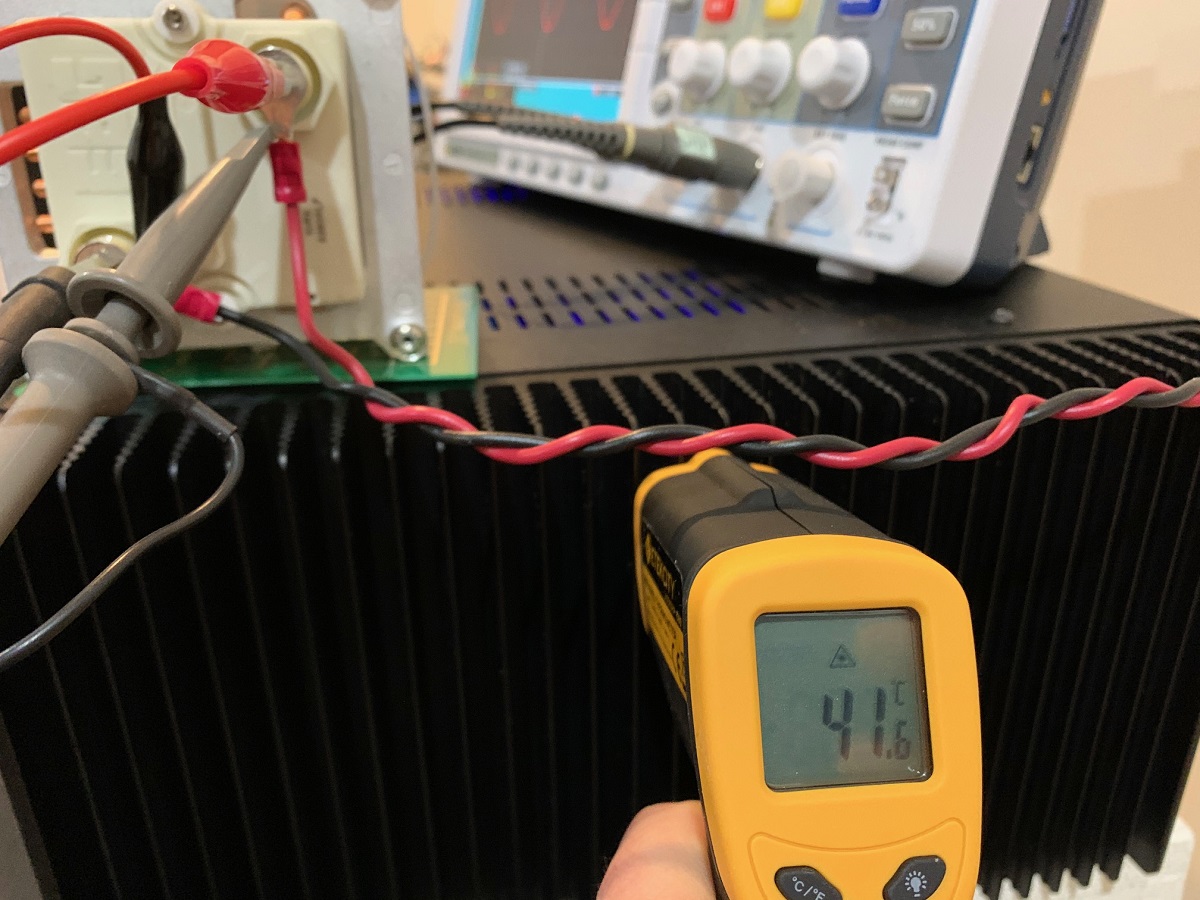
Here is the IR thermometer of the amp at idle and warmed up:
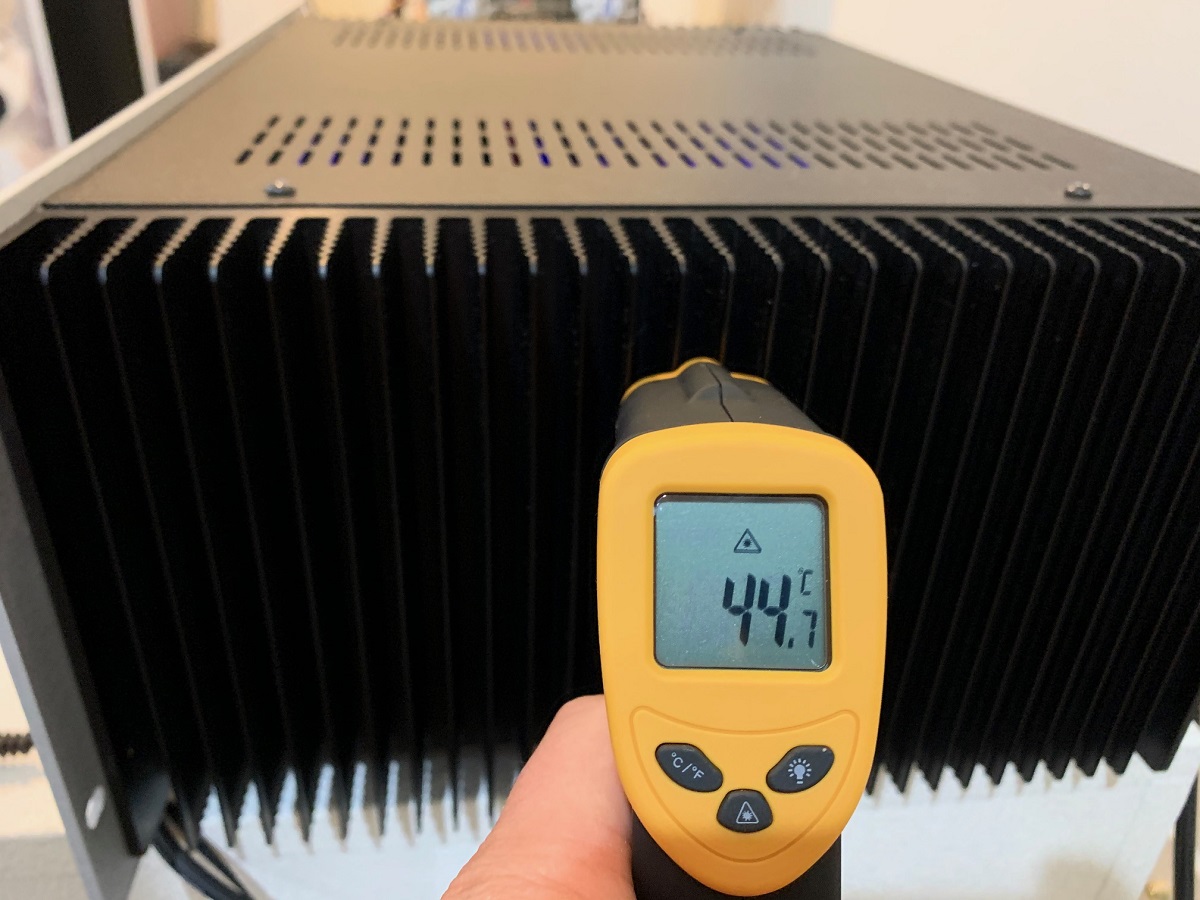
I suppose you were trying to show that if this was a push-pull amp going out of Class A and into Class AB, the temperature would not have decreased at max power?
This is consistent with what 6L6 observed with the Aleph J, another amp using the Pass active CCS.
>96 watts for an output of 40 watts into 8 ohms is around 42% class A is therefore verified... single ended even...any pp amp will have efficiency much greater than 50%
> ambient of 20 *C and sink temp of 40 *C means a temp rise of 20*C so that in my country where ambient can reach 30*C sink temp can rise 50*C, this is better than what we are getting with the NP ACA where sink temps go as high as 70*C...but the good news is that when you train a fan to the heatsinks, the sinks get colder....
With my simulator I get output impedance of 0.03 ohm DF 250 for 8 ohm . Nearly double of it at 30hz.Danny, X,
I'm not sure how the DF came out so high! I suspect from halving the output device to speaker resistor.
These are amazing figures, Danny. I will email you to discuss it.
Hugh
Attachments
Last edited:
Congratulations, Hugh and the rest of the team; the accolades keep stacking up.
I am curious if someone with access to both Alpha Nirvana and USSA-5 amplifiers have done some listening comparisons. They seem very comparable in power, if not in DF.
I am curious if someone with access to both Alpha Nirvana and USSA-5 amplifiers have done some listening comparisons. They seem very comparable in power, if not in DF.
Hello Francois,
I will have that combo of amplifiers as soon as my AN is completed.
A few projects going simultaneously and time has become thin at the moment.
Soon though......
Cheers!
I will have that combo of amplifiers as soon as my AN is completed.
A few projects going simultaneously and time has become thin at the moment.
Soon though......
Cheers!
Thanks, and very good to know! I’m sure others are wondering. Looking forward to “hearing what you hear” reviews.
- Home
- Amplifiers
- Solid State
- Alpha Nirvana 39w 8ohm Class A Amp

